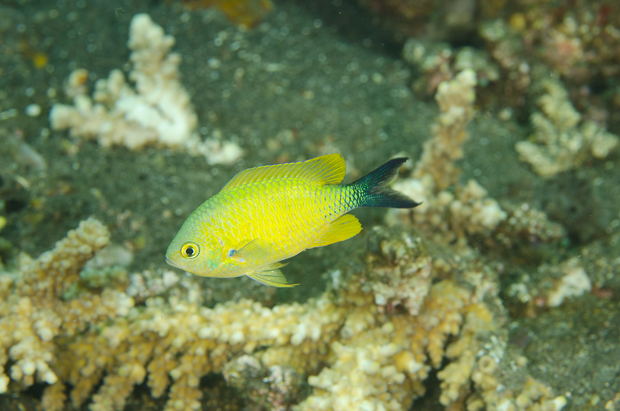The green Chromis, C. viridis, is such a staple and common aquarium fish, we hardly give a thought to how uniform this species is in the home aquarium, and in the wild. Sure you occasionally get a Chromis atripectoralis mixed in with true green chromic, but by and large, this is one fish that is as cookie cutter as a reef fish can be.
However we recently learned that this ubiquitous denizen of the reef can actually perform a wild transformation which becomes practically unrecognizable from the ocean green schooling fish we are so familiar with. The wardrobe change for green chromic happens when mature male specimens are trying to attract a female mate, and while they are laying their eggs on a surface on the reef.

We know that many male wrasses can show permanent sexual coloration, sometimes as a ‘supermale’ which is in the peak of its maturation. Meanwhile flasher and and fairy wrasses will put on a temporary display of color and pattern late in the day to attract a female with which to spawn. This variation in appearance related to reproduction is called ‘nuptial coloration’ and male green chromis engaged in the act of spawning display a color which is somewhere between permanent and temporary.
While wearing their nuptial colors, male green chromis can develop a startling black coloration to the tail, or in the pectoral fin, or both. At the same time the body color of the male can change from minty green to sulfurous yellow-green, radically changing the overall appearance of male green chromis in the act.

The color change of spawning green chromis is reminiscent of spawning freshwater cichlids, wherein both sexes generally have long term parental care of the eggs, and the young fish for a period of time after they hatch. Like all damselfish, spawning male green chromis only protect their nest of eggs until they hatch, and the degree to which males retain their spawning coloration while guarding their eggs varies, and sometimes never even develops.
Like all the aberrations and hybrid fish we fawn over, seeing familiar fish in an unfamiliar way is part of the fascination of seeing something special. However in the case of green chromis, you’ll have to get a pair in spawning mode to see the surprisingly wild coloration that is hiding within this common fish.




